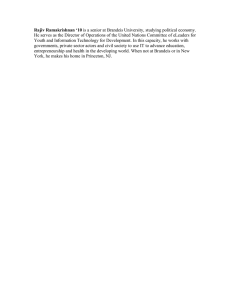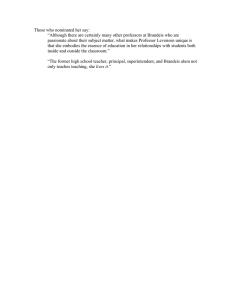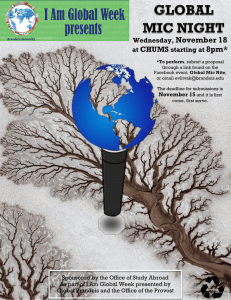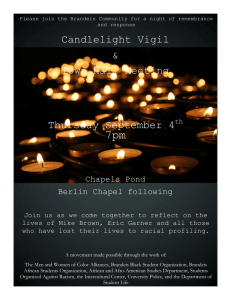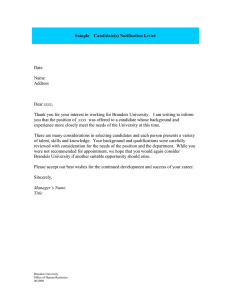Brandeis University Strategic Planning Strategic Planning Input Sessions January 24-25, 2012
advertisement
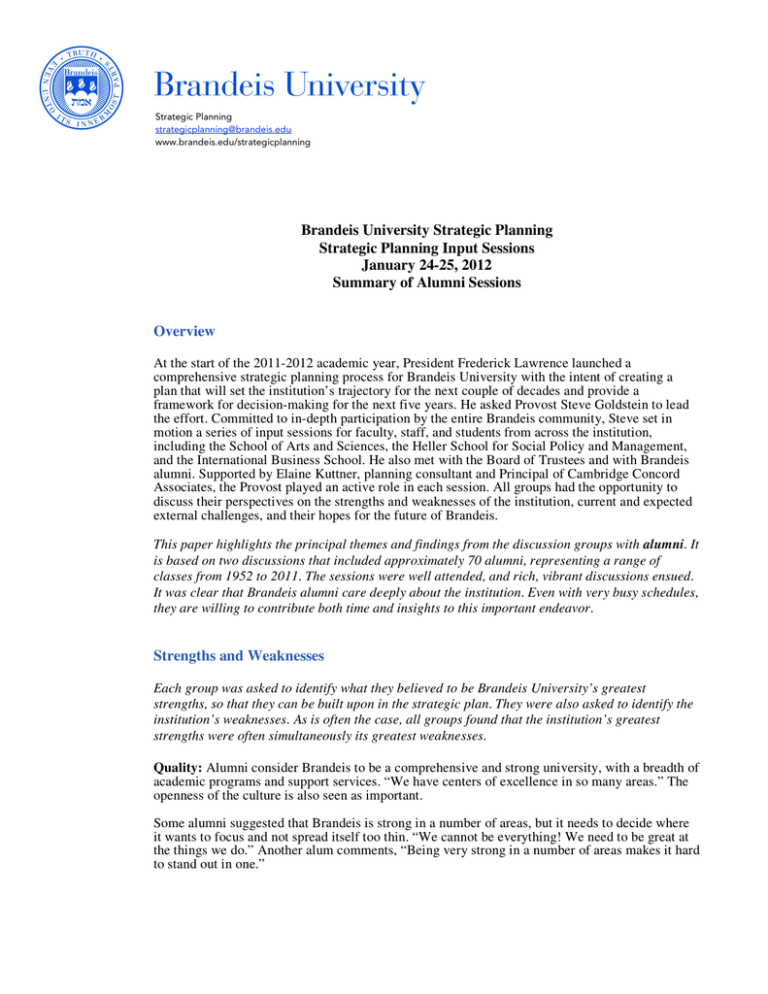
Strategic Planning strategicplanning@brandeis.edu www.brandeis.edu/strategicplanning Brandeis University Strategic Planning Strategic Planning Input Sessions January 24-25, 2012 Summary of Alumni Sessions Overview At the start of the 2011-2012 academic year, President Frederick Lawrence launched a comprehensive strategic planning process for Brandeis University with the intent of creating a plan that will set the institution’s trajectory for the next couple of decades and provide a framework for decision-making for the next five years. He asked Provost Steve Goldstein to lead the effort. Committed to in-depth participation by the entire Brandeis community, Steve set in motion a series of input sessions for faculty, staff, and students from across the institution, including the School of Arts and Sciences, the Heller School for Social Policy and Management, and the International Business School. He also met with the Board of Trustees and with Brandeis alumni. Supported by Elaine Kuttner, planning consultant and Principal of Cambridge Concord Associates, the Provost played an active role in each session. All groups had the opportunity to discuss their perspectives on the strengths and weaknesses of the institution, current and expected external challenges, and their hopes for the future of Brandeis. This paper highlights the principal themes and findings from the discussion groups with alumni. It is based on two discussions that included approximately 70 alumni, representing a range of classes from 1952 to 2011. The sessions were well attended, and rich, vibrant discussions ensued. It was clear that Brandeis alumni care deeply about the institution. Even with very busy schedules, they are willing to contribute both time and insights to this important endeavor. Strengths and Weaknesses Each group was asked to identify what they believed to be Brandeis University’s greatest strengths, so that they can be built upon in the strategic plan. They were also asked to identify the institution’s weaknesses. As is often the case, all groups found that the institution’s greatest strengths were often simultaneously its greatest weaknesses. Quality: Alumni consider Brandeis to be a comprehensive and strong university, with a breadth of academic programs and support services. “We have centers of excellence in so many areas.” The openness of the culture is also seen as important. Some alumni suggested that Brandeis is strong in a number of areas, but it needs to decide where it wants to focus and not spread itself too thin. “We cannot be everything! We need to be great at the things we do.” Another alum comments, “Being very strong in a number of areas makes it hard to stand out in one.” Strategic Planning strategicplanning@brandeis.edu www.brandeis.edu/strategicplanning Others felt that the position of Brandeis as a top quality liberal arts college within a research university was a significant strength that sets it apart from other high quality universities. “Others don’t have the same breadth or depth to draw on.” Some alumni highlighted Brandeis’s emphasis on critical thinking and the value provided by classroom discussions and interactions, both among students and between students and faculty. “Collaborative skills and critical thinking are 21st century skills that we teach that we should market.” Communicating the Brandeis Message: Many alumni expressed some frustration with the fact that Brandeis is not well known and its strengths are not appreciated. They would like to see more public relations and more promotion of Brandeis and its strengths. Some also see that alumni have a significant role to play in promoting Brandeis, with support from the university. One person pointed out the fact that many people experienced something they consider to be unique at Brandeis, but that often they “fell into it” and didn’t realize before they came what Brandeis had to offer. “We should be able to find a more effective way to explain to the rest of the world what we are, who we are, what we offer.” Jewish Identity: The Jewish identity of Brandeis emerged once again as both a strength and a challenge. On the one hand, it is what makes Brandeis truly distinctive. On the other hand it is somewhat of a “limiting factor” when it comes to diversity. Also, some alumni are not comfortable talking about this tension, and have different ways of presenting it when talking about the institution. “Sometimes we promote it, sometimes we hide it.” Social Justice Focus: The social justice focus was acknowledged as being at the core of why Brandeis was founded. The alumni discussed the fact that in the beginning, Brandeis existed to address discrimination. The intent, and the ultimate reality, was a university that was of the highest moral and ethical standards and about social justice. “Brandeis wasn’t meant to be just a university but also a fountain of knowledge and social justice, something never seen before.” “The soul of the university is found in our mission of social justice, and that’s why a lot of students come.” At the same time, some alumni noted that while there may be a focus on social justice on campus, it’s hard to take that beyond the campus, and alumni don’t find support for continuing their social justice interests. The concept of a “social justice innovation laboratory” was suggested. Students, Faculty, and Staff: Students, faculty, and staff at Brandeis are all acknowledged to be high quality. But as it moves forward, Brandeis needs to pay attention to changing demographics and address ongoing questions of how to diversify the institution. “If we want to have a range of people we must provide financial aid in new ways, be need blind, and able to provide full aid.” External Challenges and Opportunities to Consider in Planning Economic Challenges: Many people acknowledged the economic pressures on higher education, with some predicting dire outcomes. “Five to ten years from now many small places like Brandeis won’t be here, or won’t be able to maintain their quality.” The challenge is to find ways to continue to attract diverse, creative students. Strategic Planning strategicplanning@brandeis.edu www.brandeis.edu/strategicplanning The Value of a Liberal Arts Degree: As tuition rises and financial pressures continue, the value of a liberal arts education is questioned more often, and there is a greater need to “prove” the value of an expensive education as compared to a less expensive institution. Some students are looking for educational institutions that will allow them to combine a bachelor’s and a master’s degree or otherwise increase the value of their educational experience. Competition for Intellectual Resources: In the corporate world there has been an increase in “poaching” and “head hunting,” as firms compete for the top people in a field. This is likely to increase in academia as well. As senior faculty retire, there is often a tendency to hire adjuncts or junior faculty, and it’s possible to lose the competitive edge as the strongest faculty are recruited away to other institutions. Envisioning Brandeis 10 to 15 Years from Now Although the strategic plan will address a five-year horizon, it will be developed in the context of longer-term vision. The specifics of that vision have yet to be determined; however throughout the alumni input sessions, many aspects of vision were introduced. Each group was asked to envision the future of Brandeis University 10-15 years from now. The results have been organized into topic areas and are presented below. Utilize technology for global collaboration and competitiveness: Brandeis can build on its global connections and use on-line technology to strengthen them. Building alliances with topquality institutions around the world and building international collaborations can help set Brandeis apart. This needs to be technologically based, given the current and future environment. “We might not want to do on-line education, but to be competitive we have to be really with it with technology.” Build stronger links with corporations: In addition to distance collaboration, Brandeis is well situated near a number of high tech companies. There should be opportunities to build innovative programs with corporations and other entities in the area, building on Brandeis’s strengths and its social justice commitment. This might also lead to scholarships and internship opportunities for students. Create a Brandeis Law School: One specific suggestion was for The Brandeis School of Law and Social Justice, providing professional training for students while strengthening the traditional social justice base of the university. NOTE: This idea had a very strong presence in the Alumni discussions, particularly in New York. Expand recruiting to broader demographics: Demographic changes will require changing recruiting approaches to attract a broad and diverse student body. This should include reaching out to community colleges, where many students will begin their education, and reaching out to nontraditional students and life long learners. Move to a paradigm of knowledge creation: Increases in distance learning mean that the process of acquiring knowledge will become easier. Of great greater value will be the creation of knowledge, an area in which Brandeis is strong. The new paradigm might include such things as Strategic Planning strategicplanning@brandeis.edu www.brandeis.edu/strategicplanning students taking Brandeis courses before they arrive on campus. Working in local or global teams to solve real world problems; and spending time away from campus as an integral part of a Brandeis education. Build Brandeis’s reputation in social justice: Brandeis could develop an “organizing institute” that goes back to our ideals and focuses on social justice and activism. As a result, Brandeis would be known across the country and around the world for teaching people how to do good for the world and why that is important. Foster alumni involvement with Brandeis throughout their lives: Alumni represent a major resource for Brandeis. Brandeis needs to look beyond reunions and job contacts for additional ways to engage alumni with the university. Ideas include: • Find ways to connect alumni according to what they’re interested in, and/or for people at similar career levels, could energize alumni. • Create a “Brandeis Linked In” that will allow people to access Brandeis resources and work together to share information and solve problems. This could be a powerful use of technology and a way to connect alumni with each other and with the university. This should also include faculty and students. Rather than focusing on specific tasks or goals, the emphasis would be on facilitating partnerships and connections so that members of the broad Brandeis community can build their own networks and collaborations. • Identify ways to build stronger connections between alumni and students, and to foster the transition from an engaged student to an active and supportive alumnus. “The student body is disconnected from what Brandeis alums are about. Alums should really be able to tell their story.” • Reach out more to alumni and “insist that we help.” Some alumni indicated that they need nurturing and clear expectations so that they can be more helpful. • Develop alumni to be future donors. “Brandeis alums need to own the school. We should have a billion dollar endowment.”
